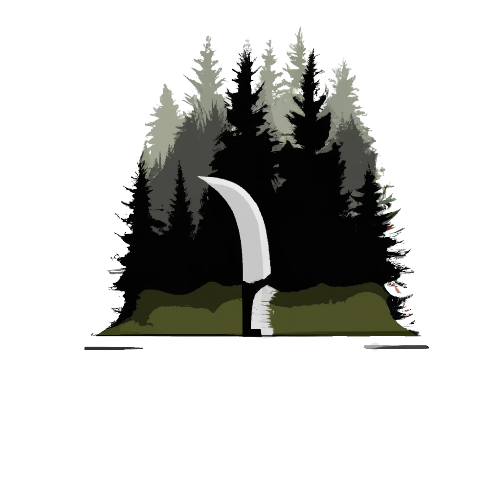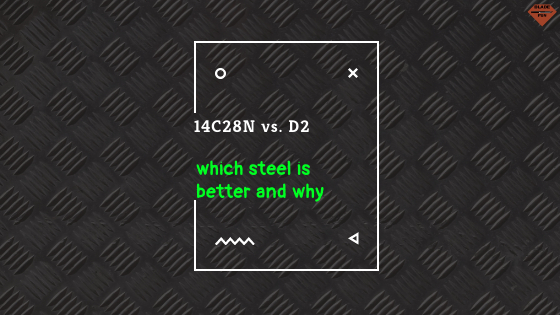D2 and 14C28N are two directly competing steels often used by the biggest name brands out there. But which one is better? Why is one better than the other? After this article, you will know everything you need to know about D2 and 14C28N.
Here is the short answer:
D2, when compared to 14C28N, has better edge retention and toughness. However, 14C28N has more chromium and less carbon than D2, so it’s going to be easier to sharpen and have better corrosion resistance. You’d use D2 if you needed a tougher blade and 14C28N if you don’t want it to rust as much.
Now we can take a closer look at each steel to get a better idea of why D2 has better edge retention and toughness and when you would want D2 over 14C28N.
D2
D2 is a tool steel as it is known for its hardness and edge retention. This means that D2 can take a beating and still work like new. D2 is used by many big knife brands because of its overall good performance as a steel.
But like any steel, D2 has its downsides. The major one being that it has almost no corrosion resistance. This means that you will need to take extra care of your knife as it will rust quite easily.
Here is what D2 is made of:
- Carbon: 1.5%
- Chromium: 12%
- Vanadium: 0.9%
- Molybdenum: 0.8%
- Magnesium: 0.45%
- Silicon: 0.4%
- Sulfur: 0.02%
Carbon increases edge retention and steel strength. Chromium helps with a steel’s corrosion resistance (D2 has a high chromium content but this is misleading as it is not very corrosion resistant in practice). Vanadium increases wear resistance. Molybdenum will increase the chances of getting a better heat treat. Magnesium, silicon, and sulfur increase steel strength much like carbon.
14C28N
14C28N is known for being an all-around good steel. It has good edge retention, good wear resistance great corrosion resistance, great toughness, and good wear resistance. So if you want a steel that performs well in all fields, then you will want 14C28N.
The downside to 14C28N is that it is not really great in any field. It is a very well-rounded steel but it doesn’t excel in any areas. if you want a good all-around steel this is the steel for you. but if you need a steel that will be good in one area more than the other this is not the steel for you.
Here is what 14C28N is made of:
- 0.62% Carbon
- 14% Chromium
- 0.6% Magnesium
- 0.2% Silicon
- 0.02% Phosphorus
- 0.01% Sulfur
- 0.11% Nitrogen
Which one is better?
Now that we have taken a more in-depth look at each steel, we can finally see which one is better.
If you value edge retention and toughness most, then you will want D2. D2 has better toughness and edge retention because it has higher carbon than 14C28N. If you are going to be using your knife a lot and do not want to sharpen it that often, you will want D2.
However, if you want more corrosion-resistant steel, then you will want 14C28N. 14C28N has more chromium, so it’s going to be better at withstanding rust and will not get stains as easily as D2. If you are going to be in an environment where rain is frequent and it’s very humid, you will want the extra stainlessness of 14C28N.
Our favorite knives in each steel
Now that we know which steel is better in which situations, we can look at what the best knives in each steel are.
Kershaw Leek 14C28N
The Kershaw Leek is an EDC knife that is awesome for any EDC purposes. The Kershaw Leek has a stainless steel handle that can get slippery, but for the most part, it fits nicely in the hand. The Leek has a 3-inch blade, is completely ambidextrous, and has assisted opening, so it has everything you would want for an EDC knife
Check out this knife here (link to Amazon)
SOG Aegis D2
The SOG Aegis is an EDC knife that is probably one of my favorite EDC knives and one I almost always reach for when I need a reliable knife to carry. The Aegis is a big knife with a 5-inch GRN handle and a 3-inch D2 blade. It has a spine safety lock and assisted opening, too.
Check out this knife here (link to Amazon)
Conclusion
If you want a very edge retentive steel, then you will want D2. But if you want a good all-around steel that is stainless, you will want 14C28N. Either steel will work for 90 percent of all knife uses, so whichever one you choose, you’ll probably be happy with it.
Check out more articles here.

